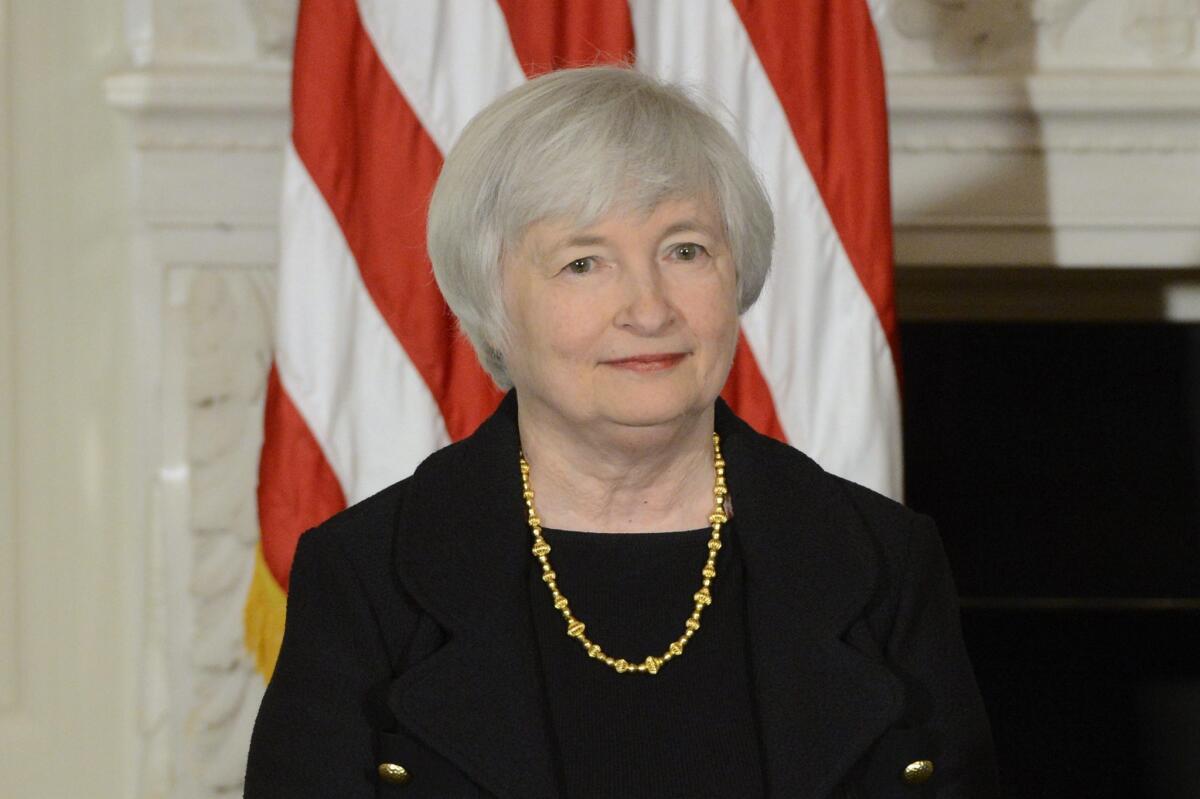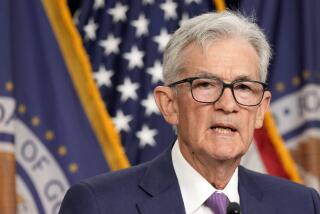Storm clouds for the Fed

- Share via
For months it was a matter of intense speculation: Who would President Obama nominate to chair the Federal Reserve? Now that he has named Janet Yellen, currently the Fed’s vice chair and an exceptionally well-qualified candidate, maybe we can move on to discussing a more important issue: the challenges facing the nation’s central bank.
After having taken extraordinary steps to support the economy since the financial crisis hit in 2008, the Fed must now engineer a return to more normal policies, and that could prove quite difficult.
The Federal Open Market Committee, the Fed’s primary policy-setting arm, projects that growth will pick up next year and remain fairly strong in 2015, driving down the unemployment rate. At the same time, it predicts inflation will continue to be subdued.
If these happy forecasts are accurate, the Fed’s job won’t be all that tough. As the Fed’s current chairman, Ben Bernanke, has signaled, the Fed would slow its purchase of assets under the quantitative easing program, eventually curtailing them altogether sometime in 2014. The following year, it would start to increase the federal funds rate and let the large stock of mortgage-backed securities on its balance sheet dwindle as households refinance or pay off their existing mortgages. No outright sales of assets would be required.
But given the Open Market Committee’s lackluster forecasting record, that happy scenario is far from certain, which means the Fed could have to confront an array of tough decisions.
One of the toughest will be how long to continue purchasing government securities under the quantitative easing program. The Fed already owns more than a third of longer-term marketable Treasury debt and roughly a quarter of the mortgage-backed securities guaranteed by the federal government. If the current pace of purchases continued until the end of 2014, the Fed could own close to half of the outstanding longer-term Treasuries and about a third of federally guaranteed mortgage-backed securities. By removing such a large share of these securities from circulation, the Fed would run the risk of impairing the operation of these crucial markets and of fueling bubbles by pushing investors to hold riskier assets.
If confronted with a persistently weak economy, the Federal Reserve will have to give up on quantitative easing at some point. And its options for filling the gap are limited. The Fed’s authority to buy other types of assets is severely constrained; notably, it cannot buy corporate bonds or stocks. As an alternative, the Fed could signal an intention to keep the federal funds rate near zero until 2016, 2017 or even beyond. But financial markets could well question the credibility of guidance so far into the future. Ultimately, the Fed might have to concede that it has run out of options, which would be a serious blow.
A different set of problems would arise if the economy took off and inflation heated up. If the economy were really racing along, the Fed would have to decide whether to sell Treasuries and mortgage-backed securities in addition to lifting the funds rate. In a rising rate environment, the value of these fixed-income securities would decline, and the Fed might end up taking a loss on the sales. Even though these would be paper losses with no economic consequences, the Fed’s critics in Congress and elsewhere doubtless would seize on an opportunity to score points.
The next Fed chairman will also need to deal with a problem that goes beyond economics: How to communicate effectively with the public. Bernanke has been an innovator on this front. He held regular news conferences, released far more detailed forecasts and frequently signaled the Fed’s likely course of future action. His goal was to make Fed policy more transparent and more predictable, and the changes have been helpful on balance. But this effort has not been fully successful.
One case in point was the Fed’s recent attempt to guide market expectations about the tapering of its securities purchases. In June, Bernanke said that the tapering would begin in the second half of the year if the Fed’s forecast for the economy were realized. Market participants took this guidance to heart, prompting a sharp rise in interest rates. As the September Open Market Committee meeting approached, observers expected the Fed to announce a taper, as there had been no communication from Bernanke or Yellen to tamp down these expectations.
In fact, the Fed had become more nervous about the outlook but hadn’t told the public, so its decision to postpone the taper came as a shock to financial markets. The whole episode was a black eye for the Fed, and another misfire like the September surprise could do lasting harm to the Fed’s credibility.
Assuming Yellen is confirmed, she will be stepping into one of the toughest jobs in America. She will need all of her formidable skill to succeed, and a healthy dose of luck.
Stephen Oliner is a senior fellow at the UCLA Ziman Center for Real Estate and a resident scholar at the American Enterprise Institute. He was formerly an associate director in the Division of Research and Statistics at the Federal Reserve Board.
More to Read
A cure for the common opinion
Get thought-provoking perspectives with our weekly newsletter.
You may occasionally receive promotional content from the Los Angeles Times.










